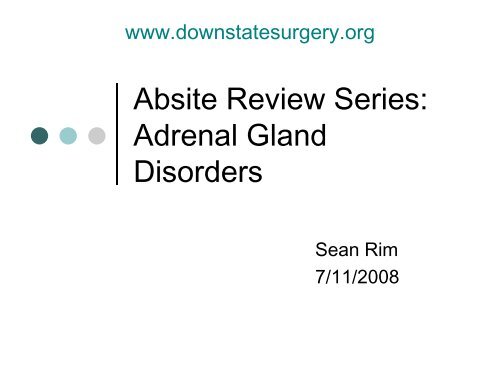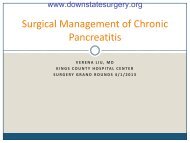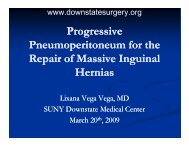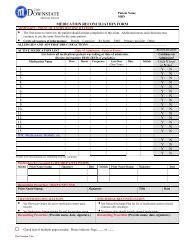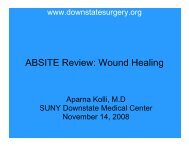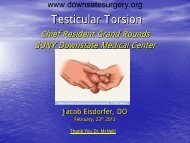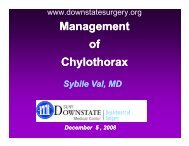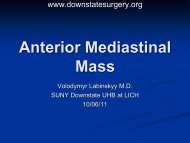Absite Review Series: Adrenal Gland Disorders
Absite Review Series: Adrenal Gland Disorders
Absite Review Series: Adrenal Gland Disorders
You also want an ePaper? Increase the reach of your titles
YUMPU automatically turns print PDFs into web optimized ePapers that Google loves.
www.downstatesurgery.org<br />
<strong>Absite</strong> <strong>Review</strong> <strong>Series</strong>:<br />
<strong>Adrenal</strong> <strong>Gland</strong><br />
<strong>Disorders</strong><br />
Sean Rim<br />
7/11/2008
www.downstatesurgery.org<br />
Questions<br />
Which of the following are effective initial<br />
treatments of acute adrenal insufficiency?<br />
A. Normal saline bolus<br />
B. Potassium<br />
C. IV glucocorticoids<br />
D. IV mineralocorticoids<br />
E. A and C<br />
F. All of the above
www.downstatesurgery.org<br />
Questions<br />
The most common cause of congenital<br />
adrenal hyperplasia is related to which<br />
enzyme deficiency?<br />
A. 11-hydroxylase<br />
B. 17-hydroxylase<br />
C. 3-hydroxyhydrogenase<br />
y y D. 21-hydroxylase
www.downstatesurgery.org<br />
Questions<br />
Which of the following is the most<br />
common cause of endogenous<br />
Cushing’s syndrome/disease?<br />
A. <strong>Adrenal</strong> adenoma<br />
B. <strong>Adrenal</strong> carcinoma<br />
C. Pituitary adenoma<br />
D. Ectopic ACTH
www.downstatesurgery.org<br />
Questions<br />
A CT scan demonstrates an 8 cm right<br />
adrenal mass extending into liver and<br />
kidney. Which of the following are<br />
appropriate?<br />
A. En bloc resection<br />
B. Radiation followed by en bloc resection<br />
C. Mitotane followed by en bloc resection<br />
D. Chemoradiation followed by en bloc<br />
resection
www.downstatesurgery.org<br />
Questions<br />
Which of the following are<br />
contraindications to laparoscopic<br />
adrenalectomy?<br />
A. Pheochromocytoma<br />
B. Adrenocortical cancer<br />
C. Bilateral adrenal lesions<br />
D. Prior abdominal surgery<br />
E. A and B
www.downstatesurgery.org<br />
<strong>Adrenal</strong> <strong>Gland</strong>s<br />
Paired glands with two distinct functional organs<br />
Third most highly perfused organ behind kidney and<br />
thyroid, 2000mL/kg/min<br />
• Cortex<br />
• Mesodermal<br />
• Medulla<br />
• Ectodermal
www.downstatesurgery.org<br />
<strong>Adrenal</strong> <strong>Gland</strong>s<br />
Paired glands with two distinct functional organs<br />
Third most highly perfused organ behind kidney and<br />
thyroid, 2000mL/kg/min<br />
• Cortex<br />
• Mesodermal<br />
• 4 th to 5 th week<br />
• Medulla<br />
• Ectodermal<br />
• 5 th to 6 th week
www.downstatesurgery.org<br />
<strong>Adrenal</strong> <strong>Gland</strong>s<br />
Paired glands with two distinct functional organs<br />
Third most highly perfused organ behind kidney and<br />
thyroid, 2000mL/kg/min<br />
• Cortex<br />
• Mesodermal<br />
• 4 th to 5 th week<br />
• Glucocorticoids,<br />
mineralocorticoids,<br />
sex steroids<br />
• Medulla<br />
• Ectodermal<br />
• 5 th to 6 th week<br />
• Catecholamines
www.downstatesurgery.org<br />
<strong>Adrenal</strong> <strong>Gland</strong>s<br />
Paired glands with two distinct functional organs<br />
Third most highly perfused organ behind kidney and<br />
thyroid, 2000mL/kg/min<br />
• Cortex<br />
• Mesodermal<br />
• 4 th to 5 th week<br />
• Glucocorticoids,<br />
mineralocorticoids, sex<br />
steroids<br />
• Hyperaldosteronism,<br />
Cushing’s,<br />
virilization<br />
• Medulla<br />
• Ectodermal<br />
• 5 th to 6 th week<br />
• Catecholamines<br />
• Pheochromocytoma
www.downstatesurgery.org<br />
Anatomy
www.downstatesurgery.org<br />
Anatomy<br />
Arterial supply is diffuse<br />
• Inferior phrenic artery<br />
• Juxtaceliac aorta<br />
• Renal artery
www.downstatesurgery.org<br />
Anatomy
www.downstatesurgery.org<br />
Anatomy<br />
Venous drainage is solitary<br />
• Left vein ~2 cm into renal<br />
• Right ~0.5 cm into IVC<br />
• 20% variable
www.downstatesurgery.org<br />
Anatomy
www.downstatesurgery.org
www.downstatesurgery.org
www.downstatesurgery.org<br />
Histology<br />
Cortex is 2 mm<br />
>80% mass<br />
Medulla has<br />
extensive autonomic<br />
fibers and ganglion<br />
cells
www.downstatesurgery.org
www.downstatesurgery.org<br />
<strong>Series</strong> of oxidative<br />
reactions via<br />
cytochrome P-450<br />
membrane<br />
associate<br />
enzymes<br />
Reticularis<br />
Fasiculata<br />
Glomerulosa
www.downstatesurgery.org<br />
Steroid hormones<br />
Low molecular weight, lipophilic signaling<br />
molecules<br />
Enter cells and bind to intracellular<br />
l<br />
receptors<br />
Slower response than membrane binding<br />
peptides<br />
Levels altered by ypregnancy, nephrotic<br />
syndrome, cirrhosis<br />
Metabolized in liver and excreted via kidney
www.downstatesurgery.org<br />
Mineralocorticoids<br />
Aldosterone regulates circulating fluid<br />
volume and electrolyte balance<br />
Promotes Na and Cl retention in distal<br />
tubule<br />
K and H secreted<br />
Will see expansion of BP and<br />
intracellular volume with aldosterone
www.downstatesurgery.org<br />
Mineralocorticoids<br />
Renin-angiotensin-aldosterone axis is<br />
responsive to delivery of sodium to the DCT<br />
Low sodium delivery triggers release of<br />
renin from JGA<br />
• Shock<br />
• Renal artery vasoconstriction<br />
• Hyponatremia<br />
Renin cleaves angiotensinogen (liver) to<br />
angiotensin-1<br />
ACE (lungs) cleaves to angiotensin-2
www.downstatesurgery.org<br />
Glucocorticoids<br />
Generate a catabolic state in<br />
response to stress<br />
Alters carbohydrate, protein, and lipid id<br />
metabolism to increase blood glucose<br />
Increase gluconeogensis<br />
Decrease peripheral glucose uptake<br />
Sensitizes arterial smooth muscle to<br />
beta-adrenergic stimulation
www.downstatesurgery.org<br />
Glucocorticoids<br />
Potent anti-inflammatory and<br />
immunosuppressive agents<br />
Reduce circulating lymphocyte and<br />
eosinophils and increase neutrophils<br />
Decrease cytokine and Ig production<br />
Suppress histamine release<br />
Inhibit phospholipase h A2 to reduce<br />
prostaglandins
www.downstatesurgery.org<br />
Glucocorticoids<br />
Hypothalamus release CRF into<br />
pituitary<br />
Results in ACTH secretion<br />
ACTH bind G protein coupled<br />
receptors on adrenocortical cell<br />
surface<br />
Steroidogenesis is upregulated
www.downstatesurgery.org<br />
Glucocorticoids<br />
ACTH is released in a pulsatile<br />
fashion, circadian rhythm<br />
Peak in AM<br />
Negative feedback occurs at both<br />
hypothalamic and pituitary levels
www.downstatesurgery.org
www.downstatesurgery.org<br />
Rate limiting<br />
step
www.downstatesurgery.org<br />
Exclusive to<br />
chromaffin cells
Stable<br />
metabolites<br />
used for<br />
markers<br />
www.downstatesurgery.org
www.downstatesurgery.org<br />
Catecholamines<br />
Alpha-1: Vasoconstriction of skin and<br />
GI tract<br />
Alpha-2: Attenuate sympathetic<br />
outflow in preynapse<br />
Beta-1: Increase HR and contractility<br />
Beta-2: Smooth muscle relaxation in<br />
unterus, bronchi, skeletal muscle<br />
arterioles
www.downstatesurgery.org<br />
Congenital <strong>Adrenal</strong> Hyperplasia<br />
Six enzyme defects have been<br />
identified<br />
90% caused by CYP21A2 deficiency<br />
(21-hydroxylase)<br />
Usually manifests as salt-wasting form
www.downstatesurgery.org
www.downstatesurgery.org
www.downstatesurgery.org<br />
Congenital <strong>Adrenal</strong> Hyperplasia<br />
Decreased negative feedback<br />
Hypovolemia, hyperkalemia,<br />
hyperreninemia<br />
i<br />
Shunts towards adrenal androgens<br />
Ambiguous genitalia in females<br />
Dx via elevated 17-hydroxyprogesterone<br />
Tx via glucocorticoid and mineralocorticoid<br />
replacement
www.downstatesurgery.org<br />
Questions<br />
The most common cause of congenital<br />
adrenal hyperplasia is related to which<br />
enzyme deficiency?<br />
A. 11-hydroxylase<br />
B. 17-hydroxylase<br />
C. 3-hydroxyhydrogenase<br />
y y D. 21-hydroxylase
www.downstatesurgery.org<br />
Questions<br />
The most common cause of congenital<br />
adrenal hyperplasia is related to which<br />
enzyme deficiency?<br />
A. 11-hydroxylase<br />
B. 17-hydroxylase<br />
C. 3-hydroxyhydrogenase<br />
y y D. 21-hydroxylase
www.downstatesurgery.org<br />
Primary <strong>Adrenal</strong> Insufficiency<br />
Addison’s disease<br />
• Weakness<br />
• Fatigue<br />
• Anorexia<br />
• Nausea<br />
• Weight loss<br />
• Hyperpigmentation<br />
• Hypotension<br />
• Electrolyte disturbance
www.downstatesurgery.org<br />
Primary <strong>Adrenal</strong> Insufficiency<br />
Congenital adrenal dysgenesis<br />
Defective steroidogenesis<br />
<strong>Adrenal</strong> destruction<br />
• Autoimmune<br />
• Infectious (TB, fungal, viral)<br />
• Metastases<br />
• <strong>Adrenal</strong> hemorrhage (Waterhouse-<br />
Friderichsen syndrome)
www.downstatesurgery.org<br />
Secondary <strong>Adrenal</strong> Insufficiency<br />
Steroid withdrawal<br />
Surgical cure of Cushing’s<br />
Panhypopituitarism<br />
• Neoplasm<br />
• Granulomatous disease<br />
• Sheehan’s sydrome
www.downstatesurgery.org<br />
<strong>Adrenal</strong> Crisis<br />
Life-threatening<br />
Occurs in patients with marginal<br />
function subjected to significant<br />
physiologic stress<br />
Initial treatment is volume and<br />
glucocorticoids<br />
Mineralocorticoid effects take several<br />
days
www.downstatesurgery.org<br />
Questions<br />
Which of the following are effective initial<br />
treatments of acute adrenal insufficiency?<br />
A. Normal saline bolus<br />
B. Potassium<br />
C. IV glucocorticoids<br />
D. IV mineralocorticoids<br />
E. A and C<br />
F. All of the above
www.downstatesurgery.org<br />
Questions<br />
Which of the following are effective initial<br />
treatments of acute adrenal insufficiency?<br />
A. Normal saline bolus<br />
B. Potassium<br />
C. IV glucocorticoids<br />
D. IV mineralocorticoids<br />
E. A and C<br />
F. All of the above
www.downstatesurgery.org<br />
<strong>Adrenal</strong> Insufficiency in Sepsis<br />
Acute reversible dysfunction of HPA<br />
axis<br />
>30% in critically ill patients<br />
• <strong>Adrenal</strong> ACTH resistance<br />
• Decreased sensitivity of target tissues<br />
Vasopressor dependent septic shock<br />
may benefit from 5 to 7 day course of<br />
physiologic dose steroids<br />
Minneci PC, Deans KJ, Banks SM, et al: Meta-analysis: The effect of steroids on survival and<br />
shock during sepsis depends on the dose. Ann InternMed 2004; 141:47-56.
www.downstatesurgery.org<br />
Meta-analysis: The effect of steroids on survival and shock<br />
during sepsis depends on the dose<br />
Minneci PC, Deans KJ, Banks SM, et al: Meta-analysis: The effect of<br />
steroids on survival and shock during sepsis depends on the dose. Ann<br />
InternMed 2004; 141:47-56.
www.downstatesurgery.org<br />
Meta-analysis: The effect of steroids on survival and shock<br />
during sepsis depends on the dose<br />
Minneci PC, Deans KJ, Banks SM, et al: Meta-analysis: The effect of<br />
steroids on survival and shock during sepsis depends on the dose. Ann<br />
InternMed 2004; 141:47-56.
www.downstatesurgery.org<br />
Bonus Question<br />
A patient has abdominal pain, T 102, systolic<br />
BP 60, HR 120, labored breathing.
www.downstatesurgery.org<br />
Bonus Question<br />
A patient has abdominal pain, T 102, systolic<br />
BP 60, HR 120, labored breathing. Dr. Kurtz<br />
asks you what the cortisol level. Your response<br />
is
www.downstatesurgery.org<br />
Bonus Question<br />
A patient has abdominal pain, T 102, systolic<br />
BP 60, HR 120, labored breathing. Dr. Kurtz<br />
asks you what the cortisol level. Your response<br />
is<br />
• A. The sepsis protocol is stupid
www.downstatesurgery.org<br />
Bonus Question<br />
A patient has abdominal pain, T 102, systolic<br />
BP 60, HR 120, labored breathing. Dr. Kurtz<br />
asks you what the cortisol level. Your response<br />
is<br />
• A. The sepsis protocol is stupid<br />
• B. The ER never sent it
www.downstatesurgery.org<br />
Bonus Question<br />
A patient has abdominal pain, T 102, systolic<br />
BP 60, HR 120, labored breathing. Dr. Kurtz<br />
asks you what the cortisol level. Your response<br />
is<br />
• A. The sepsis protocol is stupid<br />
• B. The ER never sent it<br />
• C. It’s pending but the patient was already<br />
started on steroids (physiologic dose)
www.downstatesurgery.org
www.downstatesurgery.org
www.downstatesurgery.org<br />
Primary Hyperaldosteronism<br />
Resistant hypertension and<br />
hypokalemia<br />
1% of patients with hypertension<br />
Mean age at diagnosis ~50<br />
Slight male predilection<br />
Symptoms usually related to<br />
hypokalemia
www.downstatesurgery.org<br />
Primary Hyperaldosteronism<br />
Potentially curable cause of significant<br />
cardiovascular disease<br />
Higher risk for stroke, MI, a-fib, LV<br />
hypertrophy compared to age and<br />
systolic BP matched controls<br />
Risks decrease with successful<br />
removal of aldosteronoma<br />
Responsiveness to spironolactone is<br />
a good prognostic sign<br />
Milliez P, Girerd X, Plouin PF, et al: Evidence for an increased rate of cardiovascular events in<br />
patients with primary al-dosteronism. J Am Coll Cardiol 2005; 45:1243-1248.
www.downstatesurgery.org<br />
Evidence for an increased rate of cardiovascular events in<br />
patients with primary aldosteronism<br />
124 patients with primary<br />
hyperaldosteronism over a three year<br />
period<br />
465 age and BP matched controls<br />
• Stroke 12.9% vs 3.4%<br />
• MI 4% vs 0.6%<br />
• Atrial fib 7.3% vs 0.6%<br />
Milliez P, Girerd X, Plouin PF, et al: Evidence for an increased rate of cardiovascular events<br />
in patients with primary al-dosteronism. J Am Coll Cardiol 2005; 45:1243-1248.
www.downstatesurgery.org<br />
Primary Hyperaldosteronism<br />
Aldosteronoma (unilateral) and<br />
idiopathic (bilateral) account for >90%<br />
Goal is to identify and lateralize
www.downstatesurgery.org
www.downstatesurgery.org
www.downstatesurgery.org<br />
Primary Hyperaldosteronism<br />
Laparoscopic adrenalectomy is the<br />
preferred method<br />
Cure in 75% to 95%<br />
• Normalize BP<br />
• Normalize plasma and urine<br />
aldosterone<br />
• Resolve hypokalemia<br />
24 hours to weeks<br />
Lal G, Duh QY: Laparoscopic adrenalectomy—indications and<br />
technique. Surg Oncol 2003; 12:105-123.
www.downstatesurgery.org<br />
Cushing’s s Syndrome<br />
Obesity<br />
Hirsuitism<br />
Amenorrhea<br />
Easy bruising<br />
Extreme muscle weakness
www.downstatesurgery.org
www.downstatesurgery.org
www.downstatesurgery.org
www.downstatesurgery.org<br />
Cushing’s s Syndrome<br />
Most common cause is exogenous<br />
Endogenous is rare<br />
• 5 to 10 per million<br />
• 75% have Cushing’s disease<br />
• ACTH-secreting pituitary adenoma<br />
• 15% Primary adrenal<br />
• 10% Ectopic ACTH<br />
• Neurodendocrine tumors<br />
• Bronchogenic malignancies
www.downstatesurgery.org<br />
Cushing’s s Syndrome<br />
5x increase in mortality<br />
• Hypertension<br />
• Diabetes<br />
• Truncal obesity<br />
Lindholm J, Juul S, Jorgensen JO, et al: Incidence and late prognosis<br />
of Cushing's syndrome: A population-based study. J Clin Endocrinol<br />
Metab 2001; 86:117-123.
www.downstatesurgery.org<br />
Questions<br />
Which of the following is the most<br />
common cause of endogenous<br />
Cushing’s syndrome/disease?<br />
A. <strong>Adrenal</strong> adenoma<br />
B. <strong>Adrenal</strong> carcinoma<br />
C. Pituitary adenoma<br />
D. Ectopic ACTH
www.downstatesurgery.org<br />
Questions<br />
Which of the following is the most<br />
common cause of endogenous<br />
Cushing’s syndrome/disease?<br />
A. <strong>Adrenal</strong> adenoma<br />
B. <strong>Adrenal</strong> carcinoma<br />
C. Pituitary adenoma<br />
D. Ectopic ACTH
www.downstatesurgery.org
www.downstatesurgery.org<br />
High does<br />
dexamethasone<br />
will not<br />
suppress<br />
ectopic ACTH
www.downstatesurgery.org<br />
Cushing’s s Syndrome<br />
Laparoscopic adrenalectomy<br />
90% successful<br />
Perioperative stress dose<br />
Hydrocortisone 100 mg IV every 8H for 3<br />
doses<br />
Tapered to physiologic replacement doses<br />
over weeks to years<br />
Failure may be due to local or distant<br />
recurrence
www.downstatesurgery.org<br />
Adrenocortical Carcinoma<br />
One per million<br />
Nearly all occur at 40 to 50 years<br />
Mean size at discovery 9-12 cm<br />
5 year survival 15% to 20%<br />
>50% functional<br />
• Cushing’s<br />
s<br />
• Virilization<br />
Icard P, Goudet P, Charpenay C, et al:Adrenocortical<br />
carcinomas: Surgical trends and results of a 253-patient series<br />
from the French Association of Endocrine Surgeons study<br />
group. World J Surg 2001; 25:891-897.
www.downstatesurgery.org
www.downstatesurgery.org<br />
Adrenocortical Carcinoma<br />
Radical OPEN surgery<br />
En bloc resection of adjacent organs<br />
and regional lymphadenectomy<br />
Right sided tumors >9 cm have high<br />
chance of invading into IVC and right<br />
heart<br />
May need cardiopulmonary bypass
www.downstatesurgery.org<br />
Adrenocortical Carcinoma<br />
Incomplete resection<br />
•
www.downstatesurgery.org<br />
Questions<br />
A CT scan demonstrates an 8 cm right<br />
adrenal mass extending into liver and<br />
kidney. Which of the following are<br />
appropriate?<br />
A. En bloc resection<br />
B. Radiation followed by en bloc resection<br />
C. Mitotane followed by en bloc resection<br />
D. Chemoradiation followed by en bloc<br />
resection
www.downstatesurgery.org<br />
Questions<br />
A CT scan demonstrates an 8 cm right<br />
adrenal mass extending into liver and<br />
kidney. Which of the following are<br />
appropriate?<br />
A. En bloc resection<br />
B. Radiation followed by en bloc resection<br />
C. Mitotane followed by en bloc resection<br />
D. Chemoradiation followed by en bloc<br />
resection
www.downstatesurgery.org<br />
Incidentaloma<br />
2.1% of autopsies<br />
1% to 4% of abdominal imaging studies
www.downstatesurgery.org<br />
Incidentaloma<br />
Size and risk of carcinoma<br />
• 6 cm = 25%<br />
Sturgeon C, Kebebew E: Laparoscopic adrenalectomy for<br />
malignancy. Surg Clin North Am 2004; 84:755-774.
www.downstatesurgery.org
www.downstatesurgery.org<br />
Metastases To <strong>Adrenal</strong>s<br />
Autopsy studies reveal 25% of adrenal<br />
involvement in patients with carcinoma<br />
50% are bilateral<br />
Lung, GI, breast, kidney, pancreas, skin<br />
Resection of isolated mets increases<br />
survival<br />
• 20 to 30 months median survival for<br />
complete resection<br />
• 12 months for incomplete resection<br />
• 6 months for no resection<br />
Sebag F, Calzolari F, Harding J, et al: Isolated adrenal<br />
metastasis: The role of laparoscopic surgery. World J<br />
Surg 2006; 30:888-892.
www.downstatesurgery.org<br />
Positioning
www.downstatesurgery.org<br />
Port Placement
www.downstatesurgery.org<br />
Right <strong>Adrenal</strong>ectomy<br />
1. Division of<br />
triangular<br />
ligament<br />
2. Divide plane<br />
between adrenal<br />
and IVC
www.downstatesurgery.org<br />
Right <strong>Adrenal</strong>ectomy<br />
1. Identify and<br />
ligate adrenal<br />
vein and<br />
arteries<br />
2. Dissect off<br />
diaphragm<br />
superiorly,<br />
kidney<br />
inferiorly
www.downstatesurgery.org<br />
Left <strong>Adrenal</strong>ectomy<br />
1. Mobilize<br />
spleen and<br />
splenic<br />
flexure<br />
2. Leave<br />
kidney in<br />
place<br />
3. Mobilize<br />
tail of the<br />
pancreas
www.downstatesurgery.org<br />
Left <strong>Adrenal</strong>ectomy<br />
1. Ligate<br />
vessels<br />
2. Dissect off<br />
kidney and<br />
diaphragm
www.downstatesurgery.org<br />
Open adrenalectomy<br />
1. Used for cancer<br />
operation<br />
2. En Bloc removal<br />
may include<br />
stomach, spleen,<br />
pancreas<br />
3. Take periadrenal<br />
fat and lymphatic<br />
tissue
www.downstatesurgery.org<br />
Questions<br />
Which of the following are<br />
contraindications to laparoscopic<br />
adrenalectomy?<br />
A. Pheochromocytoma<br />
B. Adrenocortical cancer<br />
C. Bilateral adrenal lesions<br />
D. Prior abdominal surgery<br />
E. A and B
www.downstatesurgery.org<br />
Questions<br />
Which of the following are<br />
contraindications to laparoscopic<br />
adrenalectomy?<br />
A. Pheochromocytoma<br />
B. Adrenocortical cancer<br />
C. Bilateral adrenal lesions<br />
D. Prior abdominal surgery<br />
E. A and B
www.downstatesurgery.org<br />
References<br />
Minneci PC, Deans KJ, Banks SM, et al: Meta-analysis: The effect of steroids on survival and<br />
shock during sepsis depends on the dose. Ann InternMed 2004; 141:47-56.<br />
Milliez P, Girerd X, Plouin PF, et al: Evidence for an increased rate of cardiovascular events in<br />
patients with primary al-dosteronism. J Am Coll Cardiol 2005; 45:1243-1248.<br />
Lal G, Duh QY: Laparoscopic adrenalectomy—indications and technique. Surg<br />
Oncol 2003; 12:105-123.<br />
Lindholm J, Juul S, Jorgensen JO, et al: Incidence and late prognosis of Cushing's syndrome: A<br />
population-based study. J Clin Endocrinol Metab 2001; 86:117-123.<br />
Icard P, Goudet P, Charpenay C, et al: Adrenocortical carcinomas: Surgical trends and results<br />
of a 253-patient series from the French Association of Endocrine Surgeons study group. World<br />
J Surg 2001; 25:891-897.<br />
Dackiw AP, Lee JE, Gagel RF, et al: <strong>Adrenal</strong> cortical carcinoma. World J Surg 2001; 25:914-<br />
926.<br />
Sturgeon C, Kebebew E: Laparoscopic adrenalectomy for malignancy. Surg Clin North<br />
Am 2004; 84:755-774.<br />
Sebag F, Calzolari F, Harding J, et al: Isolated adrenal metastasis: The role of laparoscopic<br />
surgery. World J Surg 2006; 30:888-892.
www.downstatesurgery.org<br />
Questions<br />
1. Which of the following are effective initial treatments of acute adrenal insufficiency?<br />
A. Normal saline bolus<br />
B. Potassium<br />
C. IV glucocorticoids<br />
D. IV mineralocorticoids<br />
E. A and C<br />
F. All of the above<br />
2. The most common cause of congenital adrenal hyperplasia is related to which enzyme deficiency?<br />
A. 11-hydroxylase<br />
B. 17-hydroxylase<br />
C. 3-hydroxyhydrogenase<br />
D. 21-hydroxylase<br />
3. Which of the following is the most common cause of endogenous Cushing’s syndrome/disease?<br />
A. <strong>Adrenal</strong> adenoma<br />
B. <strong>Adrenal</strong> carcinoma<br />
C. Pituitary adenoma<br />
D. Ectopic ACTH<br />
<br />
<br />
A CT scan demonstrates an 8 cm right adrenal mass extending into liver and kidney. Which of the following are<br />
appropriate?<br />
A. En bloc resection<br />
B. Radiation followed by en bloc resection<br />
C. Mitotane followed by en bloc resection<br />
D. Chemoradiation followed by en bloc resection<br />
Which of the following are contraindications to laparoscopic adrenalectomy?<br />
A. Pheochromocytoma<br />
B. Adrenocortical cancer<br />
C. Bilateral adrenal lesions<br />
D. Prior abdominal surgery<br />
E. A and B


